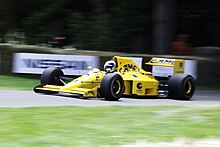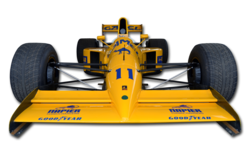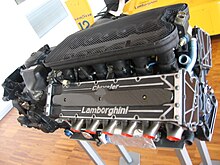Lotus 102
| Constructor: |
|
||||||||
| Designer: | Frank Dernie | ||||||||
| Predecessor: | Lotus 101 | ||||||||
| Successor: | Lotus 102B | ||||||||
| Technical specifications | |||||||||
|---|---|---|---|---|---|---|---|---|---|
| Chassis: | Monocoque made of fiber-reinforced plastic | ||||||||
| Wheelbase: | 2950 mm | ||||||||
| Weight: | 505 kg | ||||||||
| Tires: | Goodyear | ||||||||
| Petrol: | BP | ||||||||
| statistics | |||||||||
| Driver: |
|
||||||||
| First start: | 1990 Brazilian Grand Prix | ||||||||
| Last start: | 1990 Australian Grand Prix | ||||||||
|
|||||||||
| World Cup points: | 3 | ||||||||
| Podiums: | - | ||||||||
| Leadership laps: | - | ||||||||
The Lotus 102 was a Formula 1 racing car from the British racing team Lotus , which was first used in the 1990 Formula 1 season . Together with its evolutionary stages 102B and 102D , it had a total of 37 races until it was replaced by the Lotus 107 after the 1992 season . The Typ102 fell short of expectations in all development phases and was only able to achieve 8 championship points.
Technical specifications

The racing car was designed by the technical director of the Lotus team, Frank Dernie , during the 1989/90 winter break under great time pressure. Dernie attributed the quality of the vehicle, which had been further developed from the Lotus 101 , to the far too short planning and construction time. The monocoque made of synthetic resin reinforced with carbon and aramid fibers turned out to be problematic, as it turned out to be not torsionally rigid enough.
In qualifying for the 1990 Spanish Grand Prix in Jerez de la Frontera , Martin Donnelly had a serious accident . His car took a quick right bend off the lane and hit the guardrail at high speed. As a result of the impact, the vehicle broke and Donnelly and his seat, to which he was strapped, was thrown onto the track. Despite serious injuries, he survived the accident, but had to end his Formula 1 career.
The monocoque problem could only be solved during the course of the season. A total of five chassis were manufactured. One of the most striking changes compared to the previous year's car were the modified rear and the larger side pods.
The engine of the Lotus 102 with the type designation 3512 came from Lamborghini . The uncharged twelve-cylinder V-engine weighed 145 kg. With a displacement of 3,498 cm³, it developed a maximum of approx. 470 kW at a speed of around 13,000 rpm. In order to do justice to the increased performance and the increased gasoline consumption, Dernie had to increase the content of the gasoline tank to 220 liters and install larger and therefore heavier oil and water coolers. The manual transmission, also from Lamborghini, had six forward and one reverse gears. The braking system came from Brembo and the shock absorbers from Bilstein . All wheels were individually suspended from double wishbones .
sponsor
The main sponsor was the cigarette brand Camel , which belongs to the Tobacco group .
Season course
As a result, the Lotus 102 was a constructive flop. Derek Warwick and Martin Donnelly , respectively Johnny Herbert as a substitute driver for Donnely, who had an accident at the Spanish Grand Prix , tried mostly in vain for good placements. As a result, Tobacco terminated the sponsorship relationship with Lotus in August 1990 at the end of the year. Engine supplier Lamborghini also ended its collaboration with Lotus in view of the poor results. Overall, only Warwick could bring in three world championship points for Lotus in the 1990 season, which meant eighth place in the constructors' championship.
| driver | No. | 1 | 2 | 3 | 4th | 5 | 6th | 7th | 8th | 9 | 10 | 11 | 12 | 13 | 14th | 15th | 16 | Points | rank |
|---|---|---|---|---|---|---|---|---|---|---|---|---|---|---|---|---|---|---|---|
| 1990 Formula 1 season |
|
|
|
|
|
|
|
|
|
|
|
|
|
|
|
|
3 | 8th. | |
|
|
11 | DNF | DNF | 7th | DNF | 6th | 10 | 11 | DNF | 8th | 5 | 11 | DNF | DNF | DNF | DNF | DNF | ||
|
|
12 | DNF | DNF | 8th | DNF | DNF | 8th | 12 | DNF | DNF | 7th | 12 | DNF | DNF | DNS | ||||
|
|
12 | DNF | DNF | ||||||||||||||||
| Legend | ||
|---|---|---|
| colour | abbreviation | meaning |
| gold | - | victory |
| silver | - | 2nd place |
| bronze | - | 3rd place |
| green | - | Placement in the points |
| blue | - | Classified outside the point ranks |
| violet | DNF | Race not finished (did not finish) |
| NC | not classified | |
| red | DNQ | did not qualify |
| DNPQ | failed in pre-qualification (did not pre-qualify) | |
| black | DSQ | disqualified |
| White | DNS | not at the start (did not start) |
| WD | withdrawn | |
| Light Blue | PO | only participated in the training (practiced only) |
| TD | Friday test driver | |
| without | DNP | did not participate in the training (did not practice) |
| INJ | injured or sick | |
| EX | excluded | |
| DNA | did not arrive | |
| C. | Race canceled | |
| no participation in the World Cup | ||
| other | P / bold | Pole position |
| SR / italic | Fastest race lap | |
| * | not at the finish, but counted due to the distance covered |
|
| () | Streak results | |
| underlined | Leader in the overall standings | |
literature
- Jean-François Krause: Vehicle data sheet: Lotus 102-Lamborghini. Desperate attempt. In: The large Formula 1 archive. Weltbild Verlag, Augsburg, o. P.
- Anthony Pritchard: Lotus: The Competition Cars-All the Racing Type Numbers from 1947 to the Modern Era. Haynes Publishing, Sparkford 2006, ISBN 978-1-84425-006-6 , pp. 199 and 255.
- Achim Schlang: Grand Prix. The races for the 1990 Automobile World Championship. Motorbuch Verlag, Stuttgart 1990, ISBN 978-3-613-01350-6 , p. 26 f.
Web links
- YouTube: "Donnelly LOTUS LAMBORGHINI 102" : Martin Donelly in the Lotus 102 at the Goodwood Festival of Speed
- YouTube: "1990 Lotus 102 Formula 1" : Test bench run of the 102 with the Lamborghini V12


